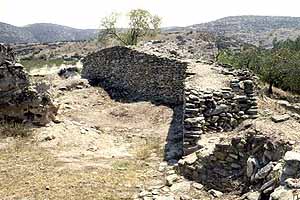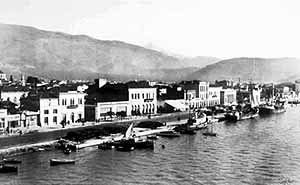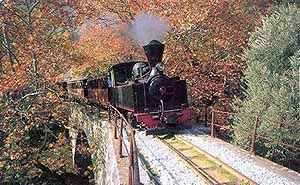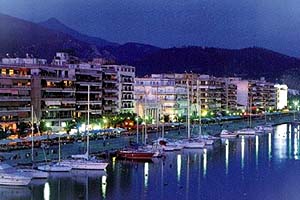History of Volos
Mythology
|
Some of the most important pages of the greek mythology are dedicated to Volos area. The mythological chieftain of Magnesia was Magnes, son of Aeolus and Aenareti. He settled down in Pilio, which is also known as the mountain that was inhabited by the Centaures. The Centaures were fabulous creatures with human head and horse's body that came about from Ixiona's and Nefeli's mythological union. A well known Centaur had been Heiron, who was Asclepius' and Achilles' teacher and who intervened for Thetis's marriage with Pileus. The wedding took place in Pilio and it was attended by many gods and heroes. According to mythology, during this wedding and because of "the apple of Eris" the Troian war was sparked off. The Argonautical Enterprise, a well known mythological fact with historical implications, had also started from the mycenean city of lolkos.
Prehistory and History
|
The first populations that settled down in the area date back to the early prehistoric period (7.000 B.C.). Some of the most important Neolithic sites, not only for Greece but for the major area of the Balkans, are located in this area. Up until now, the archaelogical research has brought to light more than 40 Neolithic settlements (7.000 - 4.000 B.C.), some of which continued to exist until the Bronze Age (3.000 - 1.000 B.C.). The most important settlements of this period in the area, which one can also visit, are Sesklo and Dimini.
The citadel of Sesklo is located in a distance of about 15 kilometres away from Volos, next to the village that brings the same name. The Neolithic settlement was covering an area of about 200.000 m2 and at its peak period (5.000 B.C.) comprised about 500 - 800 houses. Remarkable findings coming from this settlement include painted pottery, stoned tools, as well as objects made out of obsian, a material that was coming mainly from the island of Milos.
The settlement of Dimini is located on a low hill, in a distance of about 5 kilometres way from Volos. It was inhabited at about the end of the 5th millenium B.C., covering an area of about 30.000 m2, whereas its population is estimated at 200 - 300 inhabitants. The space of Dimini settlement had been arranged in a unique way. Three pairs of walls made out of stone, had been constructed all around the settlement, in order to organize the productive activities, based on the agriculture and the communication both internal and external of its inhabitants.
According to the results of the most recent research, in the east of the hill of Dimini's prehistoric settlement, the mycenean city of lolkos (1.400 - 1.200 B.C.) was located. lolkos had been an important economic and cultural centre of the major area, during that period and its name is directly connected with the myth of the Argonautical Enterprise.
During the historical times sites of importance had been the following : Pagasses (6th century B.C.), where today's place Bourboulithra at the town's entrance is, which reached its peak at the classical period, Amfanes (4th century B.C.), where today's place Soros is, and the ancient city on Goritsa hill, which was built on the first half of the 4th Century B.C., probably by Macedonia's king Philippus B'.
The most important establishment of the ancient and the early Byzantine period in the area was Dimitriada. It was founded in about 293 B.C. by Macedonia's king Dimitrios Poliorkitis, bringing together the neighbouring towns. Dimitriada is considered product of the political ideology of the times of Alexander the Great and his descendants. It became a strong military base for the Macedonians from where they supervised Thessaly and the southern Greece. At the same time, it has been an important trade centre that flourished from 217 B.C. until 168 B.C.. The city was built according to the system of Ippodamus and it was surrounded by a strong wall, whose remains are still saved until today. Remains of the palace, the theatre, as well as the city's aqueduct, which has been perfected by the Romans, are still present. Remarkable findings from the city's peak period (3rd - 1st century B.C.) are the painted burial stelai, which contain interesting information about that era's economy, society and art. From the 1st century A.D., Dimitriada is starting to shrivel, but the area continued to be inhabited until the 6th century A.D..
Nevertheless, today's town precedent was the settlement on the hill of Agii Theodori, where today's district of Palia is. By being continuously inhabited since the early geometrical period, it sheltered the mycenean's lolkos population, after this latter had been destroyed, and who founded there the city of lolkos of the historical times. Dimitriada's inhabitants also found shelter there in the 6th century A.D., when they started being threatened by the Slavs.
There is little information and an absence of archaeological findings for the period that follows, from the 6th century A.D. until the envasion of the castle of Palia by the Turks in 1423. There have still been referrences to the place name of Dimitriada, but we do not know whether they are to do with the city that Dimitrios Poliorkitis founded or with the castle of Palia. Nevertheless, after Konstandinople had been taken over by the Europeans of the fourth Crusade in 1204, and until 1318 when it was invaded by the Catalans, Dimitriada was ruled by the famous Byzantinian family of Melissini. The Byzantinians took over from the Catalans for a small period, in 1333. It is at that period that the place name Volos appears for the first time. From 1423, when the Turks occupy the area, until 1600 the greek population moves from the seaside areas towards Pilio and particularly towards the area of Ano Volos, where Dimitriada's bishop's headquarters had been transferred.
During the period of the turkish occupation, Pilio became the area's economic and cultural centre for the greek population. During the 18th century and particularly the end of it, Pilio flourished financially due to commercial and shipping activities.
The beginnings of Volos as a town
|
During the turkish occupation, the castle in today's area of Palia was the only inhabited area. It was inhabited by Turks and a few Jews and from about 1840 the castle became also the base of the turkish ruler (Kaimakami). In 1655, the castle was invaded by Morozini's soldiers, but the Venetian occupation did not last for long.
With the outbreak of the greek revolution in 1821, Pilio's villages took part in it, but without any success. The Turks sailed their fleet into Volos's harbour, so that they could control the area and get provisions for their forces. The greek state was established in 1829, but it did not include the district of Thessaly.
During the turkish occupation, the harbour of Volos, known as "skala", has been Thessaly's sea exit connecting it with the rest of the world. From the 18th century shipped merchandise from Egypt, Ismyr and Crete heading towards Konstandinople, would end up there. During the 19th century the lines Volos - Marseilles, Haumburg - Volos and Volos - Amversa which stopped first at Havre, came into use.
After 1840, the favourable conditions that the establishment of the greek state had created allowed the greeks to settle in the area of the Castle of Volos. The first settings were warehouses and workshops that belonged to trades people from Pilio. As time passed, more people settled where today's area of lasonos street is, extending towards today's Metamorphosi area. Until the middle of the 19th century, Volos developed into a small multicultural community, with its economy based mainly on the trading and manufacturing of goods.
From 1850 onwards foreign embassies made their appearance in Volos town and in 1853 the greek embassy. There is evidence of the existence of Volos as a community since 1856. In 1858 there were eighty houses in Volos, while the town was taking shape with wide streets parallel to the sea and narrow streets running perpendicular to it. There were schools and administrative services.
From the Annexation to the Greek state until World War II
|
Volos's annexation to the greek state in 1881 has determined its development. The area's tradition in trading and manufacturing, the natural harbour, its neighbouring to Thessaly's plain contributed to Volos becoming an important position from the geograghical and economic points of view, as it was the most northern harbour of the then greek state.
After the annexation, the construction of Thessaly's railway network started, aiming at resolving the problem of transport within Thessaly. Meanwhile, the area was being made accessible to the rest of Greece through Volos's harbour. By 1884, Volos was connected with Larissa by railway and by 1886 with Kalambaka, which promoted Volos to a commercial centre of Thessaly. Volos held this position for the first decade of the 20th century, until Thessaly became connected to the rest of Greece by railway through Larissa. At the same time, and since 1895, the Pilio railway network that was connecting Volos with Milies through Lehonia had started working - a project that was complete in 1903.
During this period Volos was slowly transforming from a small community, as it used to be at the time of the Turkish occupation, to a dynamic 20th century town.
The conditions were most favourable for the development of financial activities, which attracted various businessmen's interest, from other areas of Greece, to the area. Ever since Volos's annexation to the greek state its population increased rapidly, and while in 1889 there were 11.029 inhabitants, in 1896 there were 16.788 and in 1907 its population was 23.563 inhabitants.
The first capitals were invested in commerce and the purchase of land. But very soon the existence of capitals, of a domestic market, of easily accessible raw materials, as well as of labour offer created the presuppositions for the first industries to be founded. The first industrial achivities were mainly in the areas of agricultural machinery, cloth manufacturing and food.
Moreover, the big substructure projects that were under construction during this period, like Thessaly's railway and port-related constructions, caused foreigners and people that had been educated abroad to settle in Volos. These people functioned as the bearers of the european know-how which they transferred to the local industry.
The cosmopolitan character that the town was acquiring influenced its architecture and it contributed to the development of a remarkable cultural movement.
In 1894 the City Theatre was founded, in 1896 the Volos Gymnasium was founded, in 1908 the "Parthenagogio" and the Volos Workers Union,the first in Greece, were founded. Many unions were active like the "Fileleimon Athelfotis" (1897) which founded the Hospital, The Volos Trade Union (1897), which also ran a Statistics Department and a Business School, while in 1919 Volos Commercial and Industrial Union was founded.
Characteristic samples of the neoclassical style that dominated in architecture were the houses of Sarafopoulos (1894) and Pervanas (1900), who belonged to the upper class, while from the public buildings the Hotel of France (1884), the City Theatre (1894), and the Thessaly Railway Administration Building (1904) are worth mentioning.
During the 1930s the town's economy reaches its highest point. In 1922 about 13.000 refugees from Minor Asia settled down here, who actively contributed to the town's development.
The After-War Period
|
The Second World War interrupted temporarily the town's development. In the period 1941-1944 Volos was under the german occupation with consequences that lasted well into the 1950s. The earthquakes in 1955 also changed the aesthetic to which the town was built and they have been held responsible for the town's current appearance. The period from the earthquakes until into the 1970s is a reconstruction period. The town is built up again, the industrial zone is founded in 1962, the port activities extend and the town goes through its second development period.
From the 1980s and with the Local Authorities' contribution, the cultural issues take up a central position in the town's activities. In 1985 the Thessaly University was founded in Volos. Today's Volos town, with the substructure of a modern european town, is particularly attractive to its visitors due to its natural beauty and its strong interest in cultural issues.




